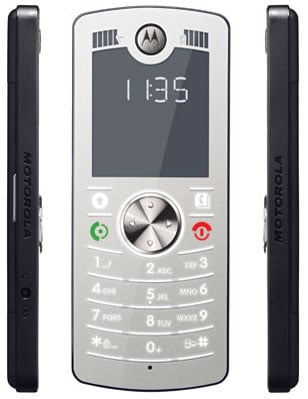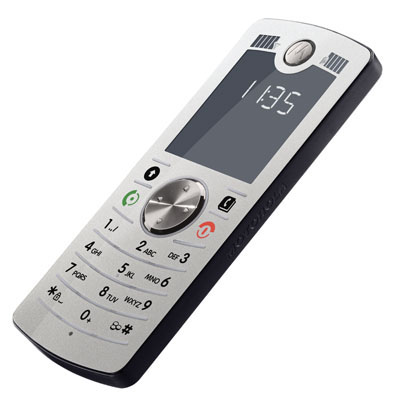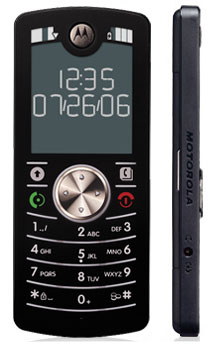Original URL: https://www.theregister.com/2007/03/29/review_motorola_motofone_f3/
Motorola Motofone F3 e-ink handset
Can a phone this basic, this cheap be any good? Yes it can
Posted in Personal Tech, 29th March 2007 10:59 GMT
Review Spiritual successor to Motorola's budget C113 handset, the new 'Motofone' F3 has clearly been designed with developing markets and the more technophobic among us in mind. All you get is a very basic phone that does nothing other than make and take calls and texts, and work as an alarm clock. That's it. No, really, that is it.

Coming in at 0.9cm deep - it's 11.4 x 4.7cm face on - this is one of the slimmest handsets around, and at 68g one the lightest too. Despite the lack of weight and thickness the whole unit feels very robust and comes clad in a reasonably scratch-resistant plastic, if the results of a few minutes of your truly prodding it with a small screwdriver are anything to go by. The battery cover clips on with a reassuring click, and when you combine that with the lack of a screen to smash - more of this in a moment - I'm fairly sure you could drop it onto a hard floor and watch it bounce right back up with little in the way of harm.
The handset itself is dominated by a large silver navigation button that along with the flush pressure-sensitive keypad works rather well. In fact, the keypad is one of the F3's real plus points - the actions are well weighted and the surface tactile, making keying errors is very rare indeed. Motorola has resisted the temptation to reduce the size of the handset by a few extra millimetres and ended up making the keypad too small for average adult fingers, and it gets a big podgy thumbs-up for that. The keypad looks well water resistant too - in fact I'd hazard a guess that it would come through a fair soaking in pretty good order, though with power and headset connections routed via a standard Motorola jack on the right of the handset it is clearly not that waterproof.
Using the F3 is a straightforward affair once you've stopped looking for the menus that aren't there because this phone doesn't do what you other phones do.

Push 'up' or 'down' on the navigation key and you can change the ring tone - you get seven, all annoying, plus a rather supine vibrate - while 'left' and 'right' scroll through the 'menu', comprising write a text, read a text, see incoming/outgoing calls, select a (still annoying) ring tone, set the alarm, and change the time and date - that's your lot. Other keys select the phone book, start and end calls, and activate selections. The twit-proof instruction leaflet isn't really all that necessary but is nevertheless a model of clarity and conciseness.
The aforementioned phone book is stored on the SIM. So change your SIM and you lose your contacts. This was a feature of the C113 and was annoying on that too. On the subject of storing information, the F3 doesn't keep sent text messages at all - more proof that voice communication is really the raison d'être for the F3.
And then there's the screen. The Screen. It's the F3's party piece. Called a ClearVision Display (CVD) it is based on e-paper from E Ink. It's conumes an extremely small amount of power as it only needs to draw energy when the display is modified, so it will continue to show information even when switched off. The downside is that all you get is a monochrome display that looks like it belongs on an LCD desktop calculator made in 1978. It consists of only two lines of text, six characters per line.
All characters are represented in upper case apart from O and D, which would otherwise be mistaken for a zero, though all texts are sent in lower case. It all works fine if the limit of your text ambitions is "how r u", but anyone prone to penning longer SMS missives and screeds may feel a little restricted, not least by the complete lack of commas, quotation marks, @ signs, hashes etc. On incoming texts anything that can't be represented correctly comes out as a hyphen, which can be rather confusion at first glance. On the plus side, what does appear correctly on the screen is large, clear and very easy to read, and that will prove a boon to the elderly or anyone with poor eyesight.
On a practical note, the CVD display has no glass screen per se to scratch or break which bodes well for longevity and for it keeping that 'just out of the box' - actually, mine came in a tube - look. The screen also works extremely well in very strong sunlight. In fact, in the direct glare of the noonday sun I have yet to see a phone display work better.

Operating on the GSM networks at the 900 and 1800MHz frequencies, call quality is consistently impressive, as is the on-board speakerphone. The ability to pick up a strong signal is also noteworthy. Motorola quotes 4.5 hours of call time and 300 hours on stand by from a single charge. If true, that's pretty impressive and from initial experience those numbers seem not far far off the mark. The SIM card rests in a slot next to the battery and is very easy to slide in and out - unlike my Sony Ericsson K610i, which requires the use of a small blade and the patience of Job to get the thing out.
Of course, price is a major factor in any review of any 'budget' phone, and at the time of writing you can get the F3 from a well-known High Street retailer whose name doesn't begin with Carphone for £25, including £10 of PAYG airtime from either T-Mobile or Virgin. A brand new slim, lightweight and unlocked handset for £15, anyone?
Verdict
The limited graphic ability of the display and lack of any on-board memory will mitigate against many people making the F3 their handset of choice, but at the price it's a perfect back up handset for use when overseas or in any situation that may result in your regular pride and joy taking a beating or indeed when your main phone just packs up or gets nicked. Add to that the fact it wants for nothing in the style stakes, and Motorola could well have a winner on its hands.